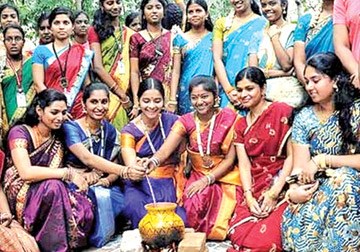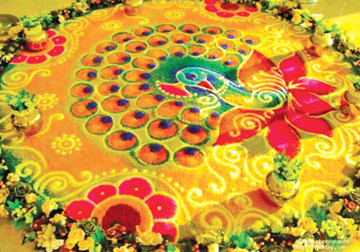Thai Pongal, the festival of farmers
A time when poor, rich, villager and city-dweller
offers thanks:
By P. Krishnaswamy
After the Christmas and New Year festivities, the focus is now on the
Pongal harvest festival, popularly known as Thai Pongal, celebrated in
the first four days of the month of Thai according to the Tamil-Hindu
calendar.
In anticipation of this colourful festival every Hindu household
begins to draw ‘Kolam’ in the front entrance of the house everyday for
one month ahead of the festival beginning from the first day of the
Hindu calendar month of ‘Margazhi” (mid December), culminating on the
day of the festival with more such drawings.
Trees which bear fruit such as sugar cane, tender coconut leaf
buntings and decorations of mango leaves adorn the houses on this
festive occasion.
 Kolam is a type of drawing practised during religious festivities and
and other celebrations by using rice flour, chalk, chalk powder, white
rock powder often using naturally or synthetically coloured powders in
Sri Lanka, Tamil Nadu and many other parts of India as also in other
countries where Hindus live. Kolam is a type of drawing practised during religious festivities and
and other celebrations by using rice flour, chalk, chalk powder, white
rock powder often using naturally or synthetically coloured powders in
Sri Lanka, Tamil Nadu and many other parts of India as also in other
countries where Hindus live.
Colourful designs
Decoration is not the sole purpose of a Kolam. In the old days,
throughout the month, front yards and entrances of houses are decorated
with Kolam in colourful designs. Kolam is more than an art.
It symbolises happiness and prosperity. Insects and birds feed on the
rice flour used for drawing the traditional Kolam. Thus, the Kolam
represents man’s concern for all living creatures. Kolams were mostly
drawn with coarse rice flour, so that the ants would not have to walk
too far or too long for a meal.
The rice powder also invited birds and other small creatures to eat
it, thus welcoming other beings into one’s home and everyday life: a
daily tribute to harmonious co-existence.
It is a sign of invitation to welcome all into the home, not the
least of whom is Lakshmi, the Goddess of prosperity and wealth. The
patterns range between geometric and mathematical line drawings around a
matrix of dots to free form art work and closed shapes.
Traditionally, Thai Pongal is the festival of farmers who depend on
Mother Earth, the sun, rain, other natural elements and cows and
buffaloes for a bountiful harvest of their staple food, rice.
In Sri Lanka, the festival is celebrated in the North, the East, the
Central Hill Country and other areas where Hindus live.
This year’s Thai Pongal is special because all displaced people have
been resettled in their original villages and places of residence and
they are back in their traditional professions, mainly agriculture and
fisheries.
Pongal is uniquely Tamil that it has been designated the ‘State
Festival’ in Tamil Nadu. Unlike in Sri Lanka, in Tamil Nadu, Pongal
festivities continue in the first four days of Thai.
Four festivals are celebrated in Tamil Nadu over the four days.
Houses are cleaned, painted and decorated. People wear new clothes and
cattle are gaily caparisoned with beads, bells and flowers – their horns
painted and capped with gleaming metal.
The first day of Pongal is Bhogi, marked by feasting and
merry-making. It is time for the new to replace the old. Huge bonfires
are lit and all unwanted items around the house are consigned to the
flames.
Traditionally all old clay utensils were ritually broken and potters
were asked to supply fresh stocks. With the advent of plastics and
steel, this ritual has now become symbolic.
Pongal is the only festival of the Hindus that follows a solar
calendar and is celebrated on mid January every year. Pongal has
astronomical significance: It marks the beginning of Uttarayana, the
Sun’s movement northward for a six-month period.
In Hinduism, Uttarayana is considered auspicious, as opposed to
Dakshinaayana, or the southern movement of the Sun. All important events
are scheduled during this period.
New ventures
Makara Sankranthi refers to the Sun entering the zodiac sign of
Makara or Capricorn. House-to-house Bajan processions are held beginning
from the lean hours of the morning and special Margazhy and
Thiruvembavai poojas are performed in temples in the month preceding
Thai.
Throughout the month, front yards and entrances of houses are
decorated with Kolam in colourful designs. Kolam is more than an art. It
symbolises happiness and prosperity. Insects and birds feed on the rice
flour used for drawing the traditional Kolam. Thus, the Kolam represents
man’s concern for all living creatures.
 Thai is an auspicious period to begin new ventures after the gloomy
period of Margazhy. There is a Tamil saying Thai Poranthal Vazhy
Porakkum, which means with the dawn of the month, a way for prosperity
and happiness will be paved. Thai is an auspicious period to begin new ventures after the gloomy
period of Margazhy. There is a Tamil saying Thai Poranthal Vazhy
Porakkum, which means with the dawn of the month, a way for prosperity
and happiness will be paved.
Pongal signals the end of the traditional farming season, giving
farmers a break from their monotonous routine. Farmers also perform
pooja to crops, signalling the end of the traditional farming season. It
also sets the pace for a series of festivals to follow in a calendar
year.
Pongal is the day when the pot of milk and rice must boil over. Early
in the morning, before sunrise, the women of the house draw intricate
kolam outside their doors. Within the perimeters of kolam, firewood is
used to cook the rice.
This is the Surya Pongal, the Pongal for the Sun God. In Sri Lanka
this and the following day’s Mattu Pongal or Pongal for the cattle are
celebrated. The Pongal is set up in direct view of the Sun (East).
Temple bells, drums, clarinets and conch shells herald the joyous
occasion of Pongal. To symbolise a bountiful harvest, rice is cooked in
new pots until they boil over.
Some of the temple rituals are the preparation of rice, chanting of
prayers and offering of vegetables, sugar cane and spices to the gods.
Devotees then consume the offerings to exonerate themselves of past
sins.
The ritual of cooking rice and milk is done in the open, in the
fields by farmers and in the courtyards and lawns of homes in the cities
and villages at a pre-determined auspicious hour.
The cooking area is decorated with flowers, sugarcane, plantain
trees, buntings of flower garlands and rice paste. The boiling over of
the contents is the auspicious sign that the family waits for and the
women folk shout in high pitch “Pongalo, Pongal”.
This is an offering to the Sun God and Mother Earth. The cooked
preparation, Pongal (made of new rice, milk and jaggery) is offered to
the gods along with preparations of vegetables and lentils, newly
harvested sugarcane and bananas. Later the family sits down to a ritual
meal.
Dedicated to cattle
The following day’s Mattu Pongal is dedicated to cattle. Cattle play
an important part in farming, thus Mattu Pongal is the day when the
cattle are worshipped and given a day of rest.
They are bathed, their horns painted with shining colours and then
they are fed and taken to the village centre where the devotees offer
them flower garlands.
A festival called Jalli Kattu is held in many places in Tamil Nadu, a
taming or controlling of the savage bull for a reward for heroism with
the participation by young men.
Bundles of money are tied to the horns of ferocious bulls which the
villagers try to retrieve. Everyone joins in the community meal, at
which the food is made of the freshly harvested grain.
Many legends are associated with Pongal celebrations. The two most
popular legends are stories related to Lord Siva and Lord Indra.
According to one, once Siva asked his bull, Basava, to go to the
earth and ask the mortals to have an oil massage and bath every day and
eat once a month. Inadvertently, Basava announced that everyone should
eat daily and have an oil bath once a month.
This mistake enraged Siva who then cursed Basava, banishing him to
live on the earth forever. He would have to plough the fields and help
people produce more food. Thus, the association of this day with cattle.
The other legend has it that during Lord Krishna’s childhood, he decided
to teach a lesson to Lord Indra who became arrogant after becoming the
king of all deities.
Lord Krishna asked all cowherds to stop worshipping Lord Indra. This
angered Lord Indra who sent forth his clouds for thunderstorms and three
days continuous rains. Lord Krishna lifted Mount Govardhan to save the
humans. According to Hindu mythology, this is when the day of the gods
begins, after a six-month long night. The festival is spread over three
days and is the most important and most fervently-celebrated harvest
festival of South India.
A special pooja is performed on the first day of Pongal before the
cutting of the paddy.
Farmers worship the sun and the earth by anointing their ploughs and
sickles with sandalwood paste. It is with these consecrated tools that
the newly-harvested rice is cut. |

